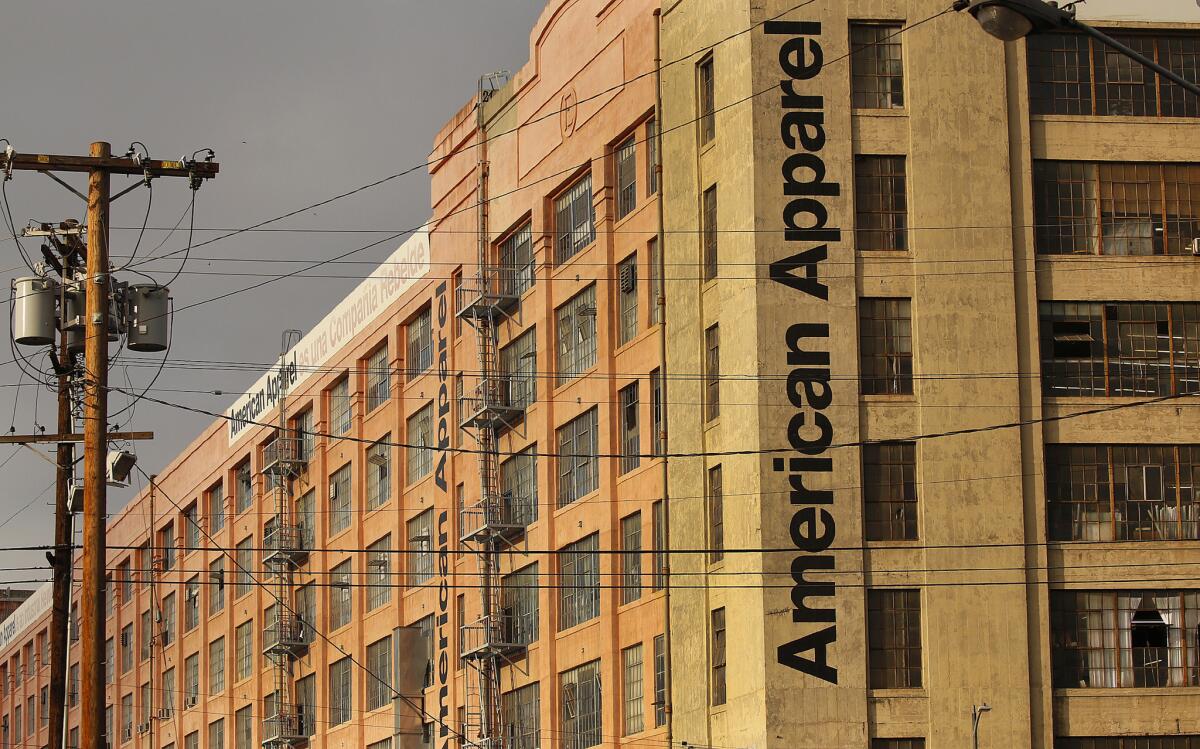American Apparel bankruptcy ruling leaves Dov Charney out in the cold

American Apparel is to reorganize under a plan put forth by its executives.
American Apparel Inc. is poised to exit bankruptcy proceedings without mercurial founder Dov Charney — but with a commitment to U.S. manufacturing.
A U.S. Bankruptcy Court judge Monday approved the Los Angeles clothier’s plan to reorganize and repay its creditors, officially ending the Charney’s reign by rendering his large ownership stake worthless.
American Apparel will instead be taken private, with control going to its largest bondholders probably within 10 days. Chief Executive Paula Schneider said the company will push ahead with its turnaround plan to cut costs and refocus design efforts while preserving its U.S. manufacturing operations.
Reached by phone Monday, an emotional Charney said he doesn’t plan to appeal the ruling because he lacks the money to do so.
The decision closes a stormy chapter for American Apparel, kicked off when its board fired Charney as chairman and chief executive in 2014 after an investigation uncovered allegations of misuse of company funds and inappropriate behavior with employees.
Since then, the retailer has been fighting off lawsuits and takeover attempts initiated by Charney and his allies while struggling to stop declining sales. The company, which filed for bankruptcy protection in October, hasn’t posted a net annual profit since 2009.
With its reorganization plan approved, American Apparel now has the chance to close underperforming stores and focus on its design and manufacturing without the pressure of Wall Street, analysts said. That gives the clothing maker some leeway to implement its turnaround strategy.
“It has the potential to be a phoenix rising from the ashes,” said Craig Johnson, president of research firm Customer Growth Partners. “It has certainly fallen on some hard times, and now they are trying to shrink the company and hopefully come out smaller but healthier going forward.”
American Apparel is not entirely free of Charney. He said he plans to pursue litigation against the company and Standard General, the hedge fund with which he originally partnered to try to regain control, but which ultimately did not back his return.
“This outcome is one that I have been working tirelessly to avoid for nearly two years in an effort to protect value for all of the company’s various stakeholders,” he said in a statement. “Now all stockholders will have their shares and value extinguished.”
But Charney, who owned more than 40% of the company’s stock, said he has assets that can’t be “stolen by a hedge fund … my ideas, values, drive and my passion,” he said. “To that end, I ask that my supporters stay tuned.”
Bankruptcy Court Judge Brendan L. Shannon rejected Charney’s efforts to derail the restructuring plan, including a $300-million takeover bid submitted by Hagan Capital Group and other investors. They supported Charney’s return as co-CEO.
Shannon said the takeover offer “doesn’t provide sufficient reason” to reject the reorganization agreement.
“I have no doubt that [Charney] wants only the best for American Apparel and especially for its thousands of employees,” Shannon said Monday.
An appeal could still be lodged within 14 days of the ruling, said Jasmin Yang, a bankruptcy attorney at Snell & Wilmer’s L.A. office. But Charney probably would be required to put up a bond, possibly in the millions of dollars, and his chances of winning on appeal are slim.
Under the approved plan, more than $200 million in bonds will be wiped out in exchange for shares in the reorganized company — a transaction known as a debt-for-equity swap.
American Apparel will also get a $40-million loan and another $40 million in equity and debt from its new owners. Annual interest payments will be slashed by about $20 million. The company will emerge from Chapter 11 with about $135 million in debt.
The participating lenders include Monarch Alternative Capital, Coliseum Capital and Goldman Sachs Asset Management. Shareholders, including Charney, will be left with nothing.
The new owners will have a long road ahead to revive the business.
Teen retailers are facing heightened competition from the likes of fast fashion rivals such as H&M and Forever 21. Many former fans have aged out of the disco pants and skimpy bodysuits that have defined the American Apparel look for years.
“The question is: Is there life for American Apparel after Dov Charney,” said Lloyd Greif, chief executive of Los Angeles investment banking firm Greif & Co. “The final chapter hasn’t been written.”
Schneider said in an interview that the reduced debt and extra liquidity would allow the company to seriously implement its turnaround plan, which includes producing new designs, streamlining offerings and slashing costs. Previously, attempts were hampered by a cash squeeze and other problems.
Schneider said she spent the last half of 2015 hiring the right employees and adding structure, including a merchandising calendar for the very first time.
But now American Apparel won’t be crippled by interest payments, Schneider said. The cash crunch meant only about 15% to 20% of last year’s fall line was actually made. The company has also been closing some underperforming stores and has renegotiated leases for others. “When you don’t have any money to buy yarn or buy marketing you are sort of hamstrung,” she said. “Now we can invest in the company. Before we were saving all of our money to make the bond payments.”
For the spring and summer, American Apparel plans to roll out about 130 new styles, Schneider said. Attracting older consumers in their 20s and 30s with more disposable income is a crucial step. That means designing clothes with different fabrics for teenagers and those who are working, Schneider said.
But changing the company’s fortunes — and its designs — will take time, she said. About 40% of items in stores is selling slowly.
“It’s not an overnight, ‘Wow, we are great,’” she said.
But American Apparel’s commitment to U.S. manufacturing will not waver, Schneider said. She wouldn’t rule out moving some manufacturing to a cheaper region of the U.S., but the goal is to keep jobs in Southern California, where about 3,650 manufacturing and sewing employees work.
Industry experts said that American Apparel may be forced to move its manufacturing to a less pricey state such as Georgia or South Carolina. Costs in Los Angeles will only rise once the city’s minimum wage is raised to $15 an hour by 2020.
“Stay tuned for the next major announcement out of the company,” Greif said. “It’s going to be: They set up shop outside the Golden State where labor costs are much lower.”
And Charney may reappear as a competitor rather than its chief cheerleader. Chad Hagan, managing partner of Hagan Capital, told Bloomberg that they “are backing Dov on a new venture.” He said it will be a rival to American Apparel, but did not elaborate.
Hagan didn’t respond to requests for comment. Charney declined to comment.
When asked about Charney, Schneider said the company has plenty of larger rivals to worry about.
“Competition is very fierce out there from the big guns,” she said. “It is what it is.”
shan.li@latimes.com







